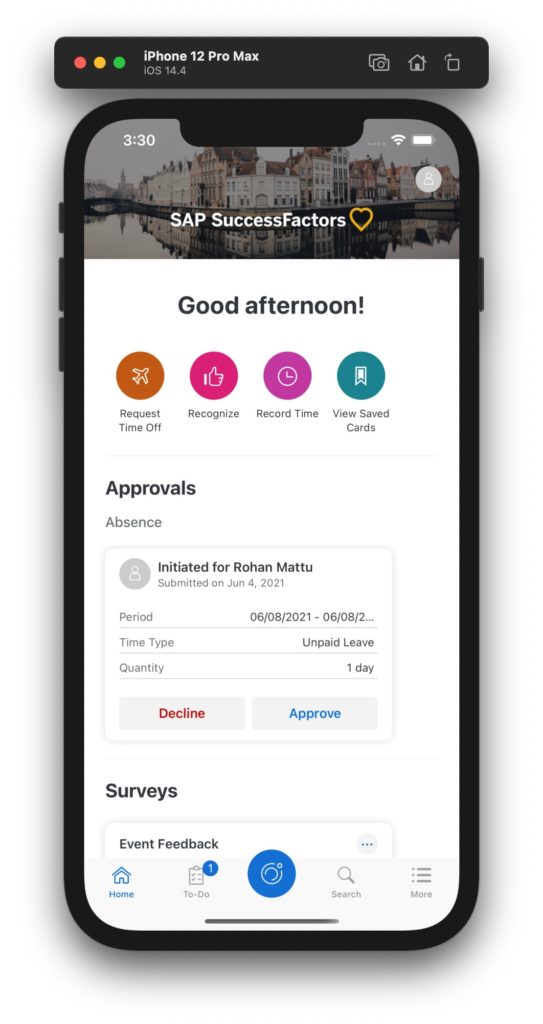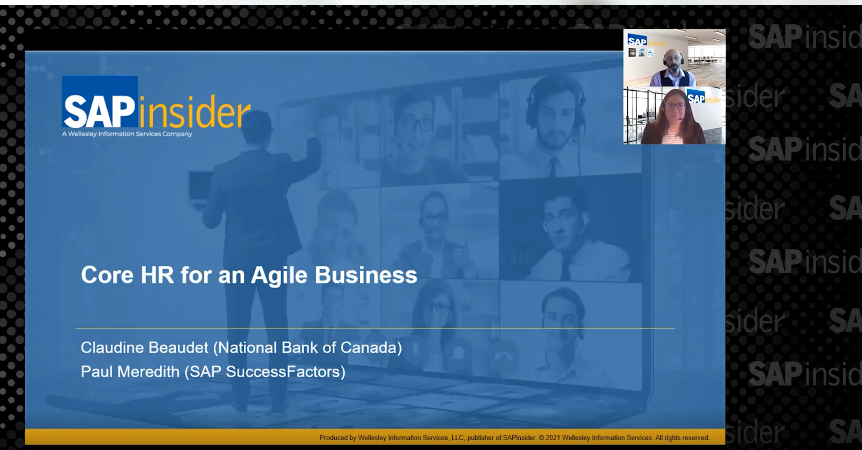How SAP SuccessFactors Brings the X-Factor to Human Capital Management
Meet the Experts
In 2019, SAP recognized that traditional notions around human capital management (HCM) needed to evolve. The concept of top-down and one-size-fits-all processes driven by human resources (HR) were no longer sufficient to meet the needs of the modern-day workforce. Following a linear path was creating silos within HR departments. As a result, SAP introduced the concept of human experience management (HXM), which focuses on putting people at the center of business.
According to Amy Wilson, SVP Products and Design at SAP SuccessFactors, “HXM allows us to recognize that people are more than just assets. They have the power to elevate or sink any sort of transformation or business initiative, and they deserve an experience that is suited to this strength.”
SAPinsider’s HCM Research Analyst Craig Powers sat down with Amy to learn about SAP SuccessFactors’ strategy around employee experience, Amy’s thoughts on how companies can successfully provide human-centered experiences for their employees, and what technology is being developed to support today’s businesses and the people that run them.
Explore related questions
Q: What is driving SAP customers to focus on employee experience? Are there outside pressures like recruiting and retention?
A: Historically there has been a connection between employee engagement and business results. But what we’re seeing now is that every business is going through some sort of transformation — whether it’s digital or cultural in nature — and in order to be successful at that you really do need to put employees at the center.
There have been different studies that show a significantly higher success rate if you can get people aligned, connected, and properly skilled in order to complete such a transformation. So having the kinds of tools and the kinds of workplace conditions to be able to support that are ever more important because of this acceleration of change and transformation.

SAP SuccessFactors’ re-imagined homepage provides information in bite-, snack-, and meal-sized experiences.
Q: What does a company need to do to provide a more human-centered experience for employees?
A: There’s certainly the technology component but before you even get to the technology you really need to think about the broader experience. One of the things that we have been evolving at SAP SuccessFactors is our experience strategy. As an industry we’ve gone from engagement surveys once a year to this concept of creating employee journeys and being able to engage people’s voices across “moments that matter,” and being able to understand and act based on those particular moments. This is still a top-down, HR-centric approach because it’s HR identifying programs that matter and asking for feedback on those topics. But if you really think about it from the human centric lens, it’s about moments that matter to me. This requires understanding that each individual is unique and that his or her whole self needs to be considered.
Each individual’s journey is much more than just big events and programs. It involves things like being able to work collaboratively with a teammate, completing a goal, or being able to take time off to care for a child. There’s a lot more that is specific to the individual that doesn’t always fall into specific HR programs. Being able to create that holistic view of what matters to people and to listen and bake that into the experience is important. It’s through that lens that you can approach human experience from a technology perspective.
Q: How is SAP SuccessFactors incorporating human experience management (HXM) into its offerings, and what is the strategy behind this?
A: It started with a combination of re-imagining experiences and adding functionality leveraging human experience design principles through a lens of what matters to and what’s required for each individual, and breaking down those boundaries.
HCM is really about driving both operational and strategic processes to the employee to have them participate and be involved and then being able to extract the data. We have a very different lens with HXM and it starts with valuing every person every day. And that kind of value comes in different forms.
First, there’s valuing each person’s time and wellbeing right now. Making things efficient, understanding that each person has a job to do, and ensuring each person is equipped to do that job.
Second, it’s about valuing each person as an individual and understanding that he or she has a voice, needs, and unique motivations. And not only recognizing that but embracing it.
Third is valuing each person’s future contribution to the organization, not just the job he or she is completing today. It’s looking at how each employee can grow along with the business, valuing each individual’s own growth and development and the opportunities that can be surfaced to them.
As a result, efficiency, individualization, and opportunity are the key principles that make up the HXM solution.
Whereas HCM would be about siloed processes, HXM is much more about connected experiences that transcend boundaries. With HCM, you might be simply tracking things like time off, pay, and benefits. But in the HXM world we consider the wellbeing and motivations of each individual.
For example, SAP SuccessFactors’ late 2020 release included capabilities and functionality to help the business encourage employees, through nudges and transparency, to take time off as well as enable them to purchase and trade time off based on eligibility and with full transparency into what that eligibility is. This functionality also helps them make that direct connection to their paycheck so that they have the flexibility and the autonomy to juggle their life and work.
Q: Can you dig into what SAP is doing with Qualtrics along with SAP SuccessFactors?
A: Embedding Qualtrics into SAP SuccessFactors has been a key part of the human experience management strategy. Giving people a voice and making the results actionable is a key part of not just the moments that matter, but the moments that matter to me. Over the course of the last year and a half we’ve been adding more “intercepts” directly into the SuccessFactors experience.
This means that any sort of data trigger can create a survey experience and collect sentiment information — whether you’re a candidate moving through different stages of the hiring process, a new employee moving through the onboarding process, or other key moments like experiencing a promotion or a manager change.
And by a survey experience, we’re not talking about a 30-question survey. It could just be a simple check-in — how are you doing — with a smiley face or frown face rating.
From a plumbing perspective we’ve created a unified administration so that right within your SAP SuccessFactors configuration, you can go ahead and turn on these intercepts with one click, free of complications and without having to create an integration with Qualtrics. It’s very simple and streamlined.
Lastly, with the latest release, we’re adding a Qualtrics sentiment capability within SAP SuccessFactors itself from a product perspective. This will also help customers understand how their employees are experiencing the technology perspective as well.
Q: What are companies doing to excel at employee experience?
A: When the concept of HXM was introduced by SAP in 2019, countless people asked me: is this just a flash in the pan? Is it just about retention during a war on talent? And I said no, this concept is going to persist.
And in fact, what we saw was that human experience management became more important than ever during the pandemic in terms of being able to connect to people, listen, understand, act, and assess what capabilities people had and how to move those around as needed. We saw incredible things coming out of our customers in terms of employee pulse surveys leveraging Qualtrics and really digging in to find out how people are feeling and getting direct feedback on things like returning to the office or what they need in their home office or what they need in terms of connecting with others or combatting stress and fatigue. Those organizations that have been able to really connect with their teams and empathize with them have built up psychological capital, trust, and capability throughout the organization. These are the companies that have been able to best endure through a lot of the change brought on by the pandemic.
Q: What else is SAP SuccessFactors looking to add moving forward?
A: When we first embarked on HXM it was really about a new way of experiencing work and re-imagining the existing experiences and making it about valuing every person every day. What we found during the last year is that not only is this absolutely necessary, but at the same time, companies are accelerating plans around redeployment and re-skilling and up-skilling like never before.
So plans that organizations had that may have been four to five years into the future were suddenly getting pulled into right now or the next 18 months. As a result, we’ve added a new component to HXM, called HXM Grow, which is all about enabling that organizational agility and enabling that business transformation around re-skilling and up-skilling.
We are building a new product that brings together pieces like learning, mentoring, assignments, and new roles into one unified experience and serves up these different opportunities to the individual based on who they are and who they are becoming and who they want to be. We’ll be launching the product later this year.
We have loads of customers that are working with us to test designs and they are very excited about being able to bring this to their people to enable more autonomous up-skilling and re-skilling, but also natural and on-the-ground redeployment. For example, managers, HR, and employees can post temporary assignments, gigs, projects, and all different kinds of assignments that are needed right now. This creates the space for people to try on new careers and new jobs for size without having to apply for a whole new life or a whole new career. And it allows for much more fluidity in terms of the workplace, as well as fluidity in people’s careers.
Recently Added SAP SuccessFactors Experiences
Re-imagined SAP SuccessFactors Home Page
“When we think about the human experience, it transcends boundaries. It’s not just about HR activities or even traditional work activities. It goes well beyond that. So, we are constructing these bite and snack experiences in such a way that they can be reused in many different forms.”
- Bites — A small amount of information, like a quick approval or completion of a goal
- Snacks — Slightly more information available on the homepage, like providing feedback or entering time off
- Meals — A little more information, like entering a promotion or completing a performance review
SAP Work Zone for HR
“The idea is that the SuccessFactors home page that has these bites and these snacks can then be brought over to one of our key forms, a new product that we launched in November 2020 called SAP Work Zone for HR, so that you can create a more holistic experience. And then again, those bites and snacks could appear in the digital assistant or they could appear in Microsoft Teams or on a proprietary portal.
- Built in collaboration between SAP SuccessFactors and SAP Business Technology Platform
- Combines things like UI cards and guided experiences through SAP workflow
- Personalization, branding, and customization to enable customers to create a unique experience for different parts of their population and for any individual










